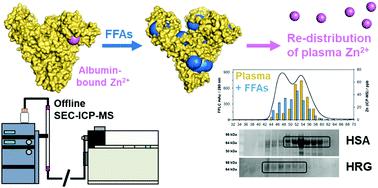当前位置:
X-MOL 学术
›
Metallomics
›
论文详情
Our official English website, www.x-mol.net, welcomes your feedback! (Note: you will need to create a separate account there.)
A metalloproteomic analysis of interactions between plasma proteins and zinc: elevated fatty acid levels affect zinc distribution.
Metallomics ( IF 3.4 ) Pub Date : 2019-10-15 , DOI: 10.1039/c9mt00177h James P C Coverdale 1 , James P Barnett 2 , Adamu H Adamu 1 , Ellie J Griffiths 1 , Alan J Stewart 3 , Claudia A Blindauer 1
Metallomics ( IF 3.4 ) Pub Date : 2019-10-15 , DOI: 10.1039/c9mt00177h James P C Coverdale 1 , James P Barnett 2 , Adamu H Adamu 1 , Ellie J Griffiths 1 , Alan J Stewart 3 , Claudia A Blindauer 1
Affiliation

|
Serum albumin is a highly abundant plasma protein associated with the transport of metal ions, pharmaceuticals, fatty acids and a variety of small molecules in the blood. Once thought of as a molecular ‘sponge’, mounting evidence suggests that the albumin-facilitated transport of chemically diverse entities is not independent. One such example is the transport of Zn2+ ions and non-esterified ‘free’ fatty acids (FFAs) by albumin, both of which bind at high affinity sites located in close proximity. Our previous research suggests that their transport in blood plasma is linked via an allosteric mechanism on serum albumin. In direct competition, albumin-bound FFAs significantly decrease the binding capacity of albumin for Zn2+, with one of the predicted consequences being a change in plasma/serum zinc speciation. Using liquid chromatography (LC), ICP-MS and fluorescence assays, our work provides a quantitative assessment of this phenomenon, and finds that in the presence of high FFA concentrations encountered in various physiological conditions, a significant proportion of albumin-bound Zn2+ is re-distributed amongst plasma/serum proteins. Using peptide mass fingerprinting and immunodetection, we identify candidate acceptor proteins for Zn2+ liberated from albumin. These include histidine-rich glycoprotein (HRG), a multifunctional protein associated with the regulation of blood coagulation, and members of the complement system involved in the innate immune response. Our findings highlight how FFA-mediated changes in extracellular metal speciation might contribute to the progression of certain pathological conditions.
中文翻译:

血浆蛋白与锌之间相互作用的金属古生物学分析:升高的脂肪酸水平影响锌的分布。
血清白蛋白是一种高度丰富的血浆蛋白,与血液中的金属离子,药物,脂肪酸和各种小分子的运输有关。一旦被认为是分子“海绵”,越来越多的证据表明白蛋白促进的化学多样性实体的运输不是独立的。一个这样的例子是白蛋白对Zn 2+离子和未酯化的“游离”脂肪酸(FFA)的转运,这两种蛋白都在紧邻的高亲和力位点结合。我们以前的研究表明,它们在血浆中的运输通过对血清白蛋白的变构机制联系在一起。在直接竞争中,白蛋白结合的FFA显着降低了白蛋白与Zn 2+的结合能力,其预期的后果之一就是血浆/血清锌形态的变化。使用液相色谱(LC),ICP-MS和荧光分析,我们的工作对这种现象进行了定量评估,发现在各种生理条件下遇到高FFA浓度时,有相当一部分白蛋白结合的Zn 2+在血浆/血清蛋白中重新分布。使用肽质量指纹图谱和免疫检测,我们确定了Zn 2+的候选受体蛋白从白蛋白中解放出来。这些包括富含组氨酸的糖蛋白(HRG),一种与血液凝固调节相关的多功能蛋白,以及参与先天免疫反应的补体系统成员。我们的发现突出了FFA介导的细胞外金属形态变化如何可能有助于某些病理状况的发展。
更新日期:2019-10-15
中文翻译:

血浆蛋白与锌之间相互作用的金属古生物学分析:升高的脂肪酸水平影响锌的分布。
血清白蛋白是一种高度丰富的血浆蛋白,与血液中的金属离子,药物,脂肪酸和各种小分子的运输有关。一旦被认为是分子“海绵”,越来越多的证据表明白蛋白促进的化学多样性实体的运输不是独立的。一个这样的例子是白蛋白对Zn 2+离子和未酯化的“游离”脂肪酸(FFA)的转运,这两种蛋白都在紧邻的高亲和力位点结合。我们以前的研究表明,它们在血浆中的运输通过对血清白蛋白的变构机制联系在一起。在直接竞争中,白蛋白结合的FFA显着降低了白蛋白与Zn 2+的结合能力,其预期的后果之一就是血浆/血清锌形态的变化。使用液相色谱(LC),ICP-MS和荧光分析,我们的工作对这种现象进行了定量评估,发现在各种生理条件下遇到高FFA浓度时,有相当一部分白蛋白结合的Zn 2+在血浆/血清蛋白中重新分布。使用肽质量指纹图谱和免疫检测,我们确定了Zn 2+的候选受体蛋白从白蛋白中解放出来。这些包括富含组氨酸的糖蛋白(HRG),一种与血液凝固调节相关的多功能蛋白,以及参与先天免疫反应的补体系统成员。我们的发现突出了FFA介导的细胞外金属形态变化如何可能有助于某些病理状况的发展。



























 京公网安备 11010802027423号
京公网安备 11010802027423号